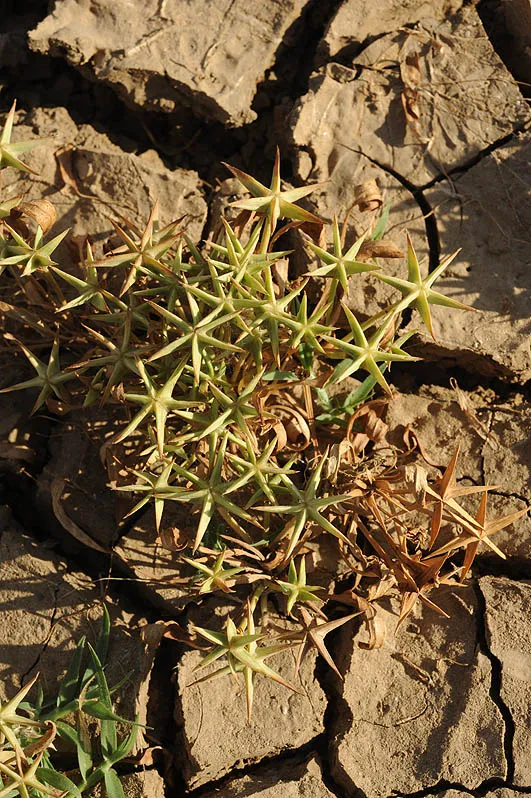Sinai Poppy
Papaver decaisnei
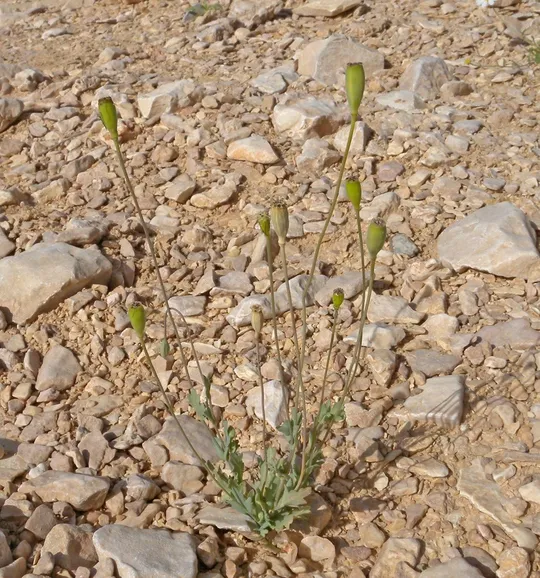
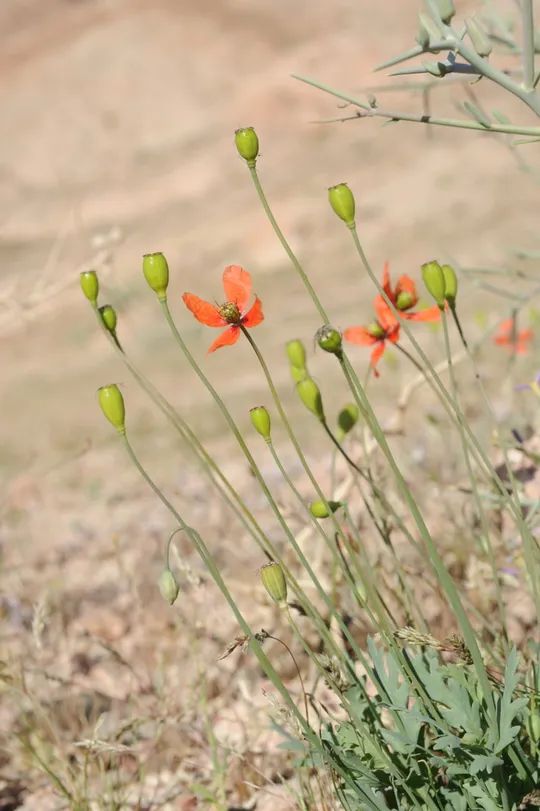
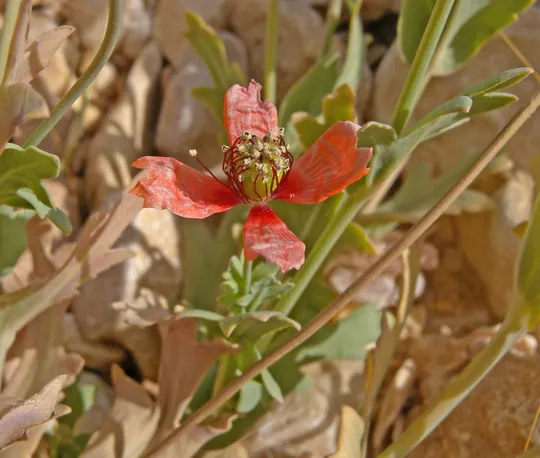
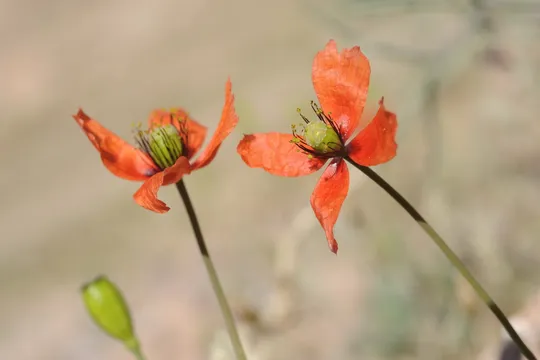
Papaver decaisnei grows in the
southern Negev and Arava regions, at a single site in each of them, a total of
two sites. The plant was discovered as a new species for Israel in 1987 in the
fields of Kibbutz Elot in the Arava. It probably arrived in one of the floods
from southern Edom Mountains. In 1990, it was discovered during a Rotem seminar
in Wadi Yaham in the southern Negev where it was also seen in 2010. The species
was probably not found there before 1990 due to its short flowering period and the
fact that it appears in the extreme desert only in rainy years.
In Israel on sandy and gravelly dry streambeds in the extreme
desert. In Sinai Papaver decaisnei grows only on
high mountains at altitudes of 900-2500 meters on slopes and wadis with coarse
sand. In Iraq and in Iran it is quite common on rocky hills and gravel and silt-rich
loess valleys at altitudes of 50-700 meters. In Jordan, it grows in west-facing
canyons in the areas of Petra and Aqaba, but is extremely rare. The population near
Elot is probably an extension of the large population growing in the Aqaba
Mountains to the east, as is the case with Matthiola arabica, Lasiospermum
brachyglossum and Artemisia judaica.
The genus Papaver numbers about 100 species found
in the temperate and subtropical areas of Eurasia, a single species that grows
in the Cabo Verde Island and one species in South Africa. The genus speciation center
is in the Middle East and the Caucasus, where 47 species grow: 35 in Turkey, 14
in Iraq and eight in Israel. The taxonomy of the genus is very complex and
there is no consensus among researchers regarding the systematic status of the
various taxons. Thus, some regard the P. umbonatum-polytrichum-carmeli
and humile complex as a single species (P. rhoeas) while others
consider it four separate species. Taxonomic research suggests that the Papaver
groups are currently evolving and speciating, which is of interests to
biological research.
P. decaisnei belongs to the Papaver section
characterized by glabrous sessile leaves clasping the stem. All the species of
the group have leaves covered with a bluish waxy coating. The species is close
to P. glaucous that is noted in the Flora of both Iraq and Jordan. Both
have small flowers and fruits and are probably mostly self-pollinating. However,
the capsule of P. glaucous has a rounded base, whereas the capsule of P.
decaisnei is elongated and narrows towards its base. Moreover, the leaves
of P. decaisnei have a narrow base and almost do
not clasp the stem. In the Flora of Iraq, there are reports of plants that show
intermediate properties between P. glaucous and P. decaisnei. P. somniferum, from which opium and codeine are extracted, also belongs to the Papaver
section and is close to these two species, but unlike P. somniferum, they have very small flowers
and fruit and dissected leaves. P. glaucous may be one of the original ancestors of P. somniferum, which would
make P. decaisnei very important as a gene pool for
the creation of new and beneficial genotypes of the cultured opium poppy P.
somniferum.
·
Papaver decaisnei has been observed
only a few times, not continuously, in the extreme southern regions in Israel. Therefore,
there is no clear information on the number of sites and the changes in their
numbers.
·
The P. decaisnei plants are scattered
in open spaces as individuals. Information on the demographic indices of the
species in Israel is incomplete. Apparently, as all Papaver species, the
capsule produces many small seeds that disperse easily, but nothing is known
about their pollination, the rate of seed creation, and their viability and
germination capacity.
·
The P. decaisnei population in the Elot
fields has not been seen for 23 years. If it still exists (in fact or in the
seed bank), it may become extinct as a result of agricultural activities or
from future development due to the urban expansion of Elat.
·
The P. decaisnei sites are not located
in nature reserves.
·
There is no information on the threat
status of P. decaisnei in the countries in
its range, but in Jordan it is extremely rare.
A geographic survey to verify the distribution of Papaver decaisnei should be conducted in the southern Negev and southern Arava during rainy years, to locate populations precisely, in order to obtain a reliable estimate regarding its status. Such a survey would provide information on the biology of the species in Israel, which could serve as a basis for a monitoring or conservation program.
Papaver decaisnei grows in the
deserts of the Middle East and Western Asia: Southern Sinai, Jordan, Saudi
Arabia, Iraq, Iran, Pakistan and Afghanistan. P. decaisnei and P. glaucous, two very close species, grow in
Jordan. This sympatric distribution suggests the possibility of their being one
taxon that should be united.
Papaver decaisnei is an extremely rare
annual plant of the southern Arava and southern Negev that was observed only a
few times in Israel. Knowledge regarding the species is limited and additional
surveys and monitoring are required to provide a better assessment of its threat
status and to recommend procedures for dealing with it.
Current Occupancy Map
| 1000 squre meter pixel | 5000 squre meter pixel | 10000 squre meter pixel | |
|---|---|---|---|
| number of observations | 0 | 0 | 0 |
| in total pixels | 0 | 0 | 0 |
| Family | Papaveraceae |
| Classification | On the endangered species list |
| Ecosystem | Desert Mountains |
| Chorotype | Irano-Turanian |
| Conservation Site | Wadi Yaham close to the plain |
| Rarity |
1
5
6
|
|---|---|
| Vulnerability |
0
1
4
|
| Attractiveness |
0
0
4
|
| Endemism |
0
0
4
|
| Red number |
1
3.7
10
|
| Peripherality | N |
| IUCN category | DD EW EX LC CR EN VU NT |
| Threat Definition according to the red book | Vulnerable |
 Based on:
Based on:



